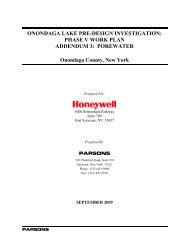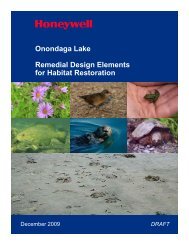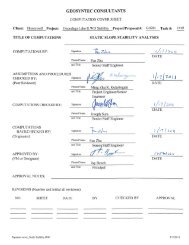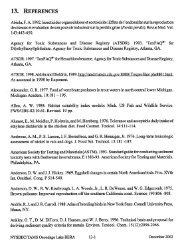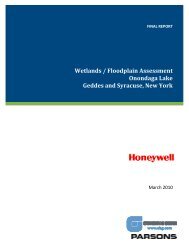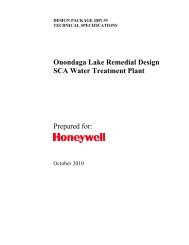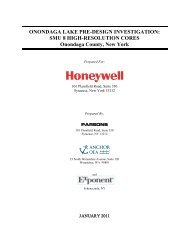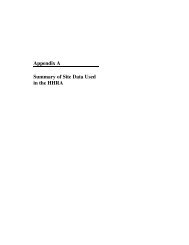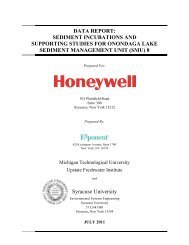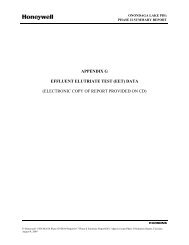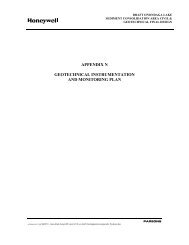Phase 1B Underwater Archaeological Report for the Onondaga ...
Phase 1B Underwater Archaeological Report for the Onondaga ...
Phase 1B Underwater Archaeological Report for the Onondaga ...
Create successful ePaper yourself
Turn your PDF publications into a flip-book with our unique Google optimized e-Paper software.
FINAL<br />
<strong>Phase</strong> IB <strong>Underwater</strong> <strong>Archaeological</strong> Resources <strong>Report</strong> <strong>for</strong> <strong>Onondaga</strong> Lake Superfund Site<br />
C: Design/<br />
Construction<br />
D:<br />
In<strong>for</strong>mation<br />
Potential<br />
The properties in <strong>the</strong> Syracuse Maritime Historic District represent a<br />
significant and distinguishable entity with features that both lack<br />
individual distinction and individually distinctive features. Contributing<br />
properties A3, A4-1, A7 and A12 because of <strong>the</strong>ir partial exposure serve<br />
as focal points <strong>for</strong> <strong>the</strong> district. They embody <strong>the</strong> distinctive<br />
characteristics of twentieth century barge construction (which include<br />
edge-fastening construction and longitudinal bulkheads); and marine<br />
infrastructure. LCMM recommends that <strong>the</strong> Syracuse Maritime Historic<br />
District is eligible under Criterion C.<br />
The sites in <strong>the</strong> Syracuse Maritime Historic District are likely to yield<br />
in<strong>for</strong>mation about early twentieth century boatbuilding techniques and<br />
<strong>the</strong>ir operational history. The contributing properties are each likely to<br />
answer specific research questions that are not addressed in <strong>the</strong> archival<br />
record. What are <strong>the</strong> structural and mechanical requirements <strong>for</strong><br />
wooden dump scows (A 3, A4-1 and A4-2)? What does <strong>the</strong> scatter of<br />
artifacts presumed to existing in proximity to Salina Pier and Iron Pier<br />
reveal about <strong>the</strong>ir use? What are <strong>the</strong> design and engineering<br />
considerations <strong>for</strong> <strong>the</strong> construction of spud holders (A12)? LCMM<br />
recommends that <strong>the</strong> Syracuse Maritime Historic District is eligible under<br />
Criterion D.<br />
Recommendations<br />
LCMM’s analysis suggests that <strong>the</strong> Syracuse Maritime Historic District retains integrity and is eligible <strong>for</strong><br />
<strong>the</strong> National Register of Historic Places under Criteria A, C and D. The remedial design <strong>for</strong> <strong>the</strong> area of <strong>the</strong><br />
Syracuse Maritime Historic District calls <strong>for</strong> dredging and capping, which would potentially impact 14<br />
sites. A3 and A76 lie outside of <strong>the</strong> remedial areas.<br />
As per <strong>the</strong> Section 106 process, LCMM recommends minimizing adverse effects to <strong>the</strong> above referenced<br />
archaeological sites. LCMM recommends dredging around each feature using a setback sufficient to not<br />
destabilize <strong>the</strong> feature. The historic property and setback would be capped consistent with surrounding<br />
area.<br />
Although <strong>the</strong> archaeological sites will be preserved in place with this proposed approach to <strong>the</strong> remedial<br />
design, adverse effects will not be eliminated. For any or all of <strong>the</strong> Syracuse Maritime Historic District<br />
properties, <strong>the</strong> proposed remedial approach may: remove through dredging related artifact collections<br />
associated with <strong>the</strong> uselife, disposal or decay of each property; adversely affect <strong>the</strong> sites’ structure<br />
through <strong>the</strong> deposition of capping material; and effectively limit <strong>the</strong> accessibly of <strong>the</strong> sites to future<br />
archaeological study.<br />
Syracuse Maritime Historic District Data Recovery<br />
Based on <strong>the</strong> recommended remedial approach, LCMM recommends mitigating <strong>the</strong> adverse effects to<br />
<strong>the</strong> Syracuse Maritime Historic District through a data recovery ef<strong>for</strong>t on <strong>the</strong> exposed portions of<br />
selected sites. The contaminated nature of <strong>the</strong> sediments overlying <strong>the</strong> sites makes mitigation through<br />
fur<strong>the</strong>r on-site data recovery from some of <strong>the</strong> sites impractical. The archaeological excavation of sites<br />
such as A55, A35, A4-2, and A38 where most of <strong>the</strong> remains are buried would require extensive<br />
excavation which could potentially disperse contaminants outside of <strong>the</strong> remediation areas, and expose<br />
researchers to potentially hazardous conditions.<br />
98



